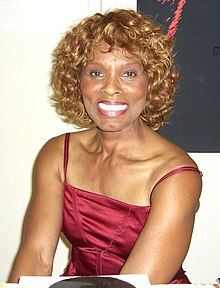Gloria Hendry
Gloria Hendry | |
|---|---|
 Hendry at the 2008 Big Apple Con | |
| Born | March 3, 1949 |
| Occupation |
|
| Years active | 1968–present |
| Known for | Rosie Carver – Live and Let Die |
| Spouse(s) | Phillip W. Wright (m. 1995) |
Gloria Hendry (born March 3, 1949)[5][6] is an American actress and former model.[7] Hendry is best known for her roles in films from the 1970s, most notably: portraying Rosie Carver in 1973's James Bond film Live and Let Die;[7] and Helen Bradley in the blaxploitation film Black Caesar,[7] and the sequel, Hell Up in Harlem.[7][8]
Biography[]
Early life and education[]
Born in Jacksonville or Winter Haven, Florida (sources differ), Hendry was the older of two daughters. Hendry's family, which consisted of her mother and sister relocated to Newark, New Jersey to live with her grandparents during her early childhood. Hendry studied at Essex College of Business for Law.[5]
Career[]
Hendry worked as a Playboy Bunny at the New York Playboy Club from 1965 until 1972.[9] In 1968, Hendry received her first acting role in Sidney Poitier's film For Love of Ivy, followed by a small role in the 1970 film The Landlord. In 1973, Hendry portrayed the Bond girl Rosie Carver in the James Bond film Live and Let Die. In that film, she became the first African American woman to become romantically involved with 007; Trina Parks, who played a nemesis to Bond rather than a love interest in Diamonds Are Forever (the previous Bond film) is considered to be the first Black Bond girl.[10]
Hendry later starred in several 1970s blaxploitation films, including Across 110th Street (1972), Slaughter's Big Rip-Off (1973), and both the 1973 films Black Caesar and its sequel Hell Up in Harlem. She also portrayed the martial arts expert, Sydney, in Black Belt Jones (1974),[7] and appeared in Savage Sisters (1974) and Bare Knuckles (1977). Her later films included the horror film Pumpkinhead II: Blood Wings (1994) and the action comedy Freaky Deaky (2012).
Personal[]
Hendry has been married once and has no children. In 1995, Hendry married Jazz musician Phillip Wayne Wright.[citation needed] She completed a memoir, entitled Gloria. In it she discusses Bond, the films of the 1970s, working as a Bunny at the famous Playboy Club in the 1960s, modeling, singing and her experiences as an African American woman during the 1960s.[citation needed]
References[]
- ^ Film Fatales: Women in Espionage Films and Television, 1962-1973, By Tom Lisanti, Louis Paul.Retrieved March 15, 2020.
- ^ Mr. Skin's Skincyclopedia: The A-to-Z Guide to Finding Your Favorite ... By Skin.Retrieved March 15, 2020.
- ^ Screen World 2001, edited by John Willis, Barry Monush.Retrieved March 15, 2020.
- ^ Reflections on Blaxploitation: Actors and Directors Speak, By David Walker, Andrew J. Rausch, Chris Watson.Retrieved March 15, 2020.
- ^ Jump up to: a b c Encyclopedia of African American Actresses in Film and Television, By Bob McCann.Retrieved March 15, 2020.
- ^ James Bond FAQ: All That's Left to Know About Everyone's Favorite Superspy, By Tom DeMichael.Retrieved March 15, 2020.
- ^ Jump up to: a b c d e "Gloria Hendry". Movies & TV Dept. The New York Times. 2014. Archived from the original on April 21, 2014.
- ^ Historical Dictionary of African American Cinema, By S. Torriano Berry, Venise T. Berry.Retrieved March 15, 2020.
- ^ "Diamond Days". December 17, 2019. Retrieved March 15, 2020.
- ^ Wilson, Julee (February 13, 2013). "Trina Parks: The First Black Bond Girl, Starred In 'Diamonds Are Forever'". The Huffington Post.
In 1971 Parks starred in the film "Diamonds Are Forever," making her the first-ever black James Bond Girl. In the movie, Parks played Thumper a bikini-clad bodyguard nemesis to Bond, who was played by Sean Connery. Although she didn't serve as one of Bond's many love interests [...]
Sources[]
- Paul, Louis (2008). "Gloria Hendry". Tales From the Cult Film Trenches; Interviews with 36 Actors from Horror, Science Fiction and Exploitation Cinema. Detroit: Wayne State University Press. pp. 90–97. ISBN 978-0-7864-2994-3.
External links[]
- Gloria Hendry at IMDb
- The Gloria Hendry Interview (about Live and Let Die)
- Gloria Hendry's Fansite (in French)
- 1949 births
- 20th-century American actresses
- 21st-century American actresses
- Actresses from Florida
- Actresses from New Jersey
- African-American actresses
- American film actresses
- American people of Chinese descent
- American people of Irish descent
- American people of Muscogee descent
- American people of Seminole descent
- Living people
- People from Winter Haven, Florida
- James Bond